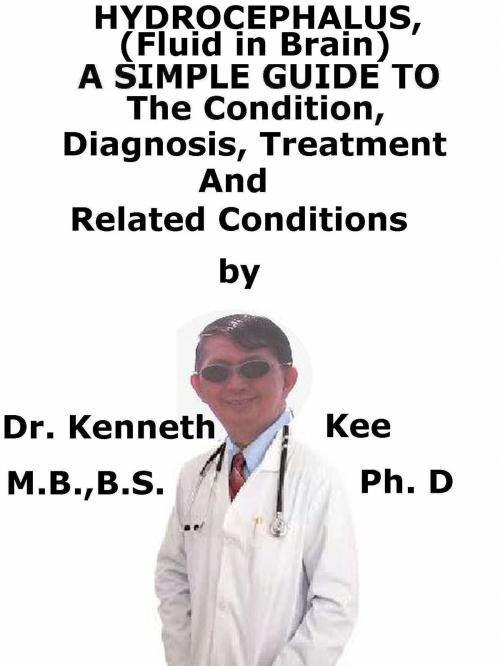Hydrocephalus, (Fluid in Brain) A Simple Guide To The Condition, Diagnosis, Treatment And Related Conditions
Nonfiction, Health & Well Being, Health, Ailments & Diseases, Nervous System & the Brain, Medical, Specialties, Internal Medicine, Neurology| Author: | Kenneth Kee | ISBN: | 9781370824298 |
| Publisher: | Kenneth Kee | Publication: | August 8, 2017 |
| Imprint: | Smashwords Edition | Language: | English |
| Author: | Kenneth Kee |
| ISBN: | 9781370824298 |
| Publisher: | Kenneth Kee |
| Publication: | August 8, 2017 |
| Imprint: | Smashwords Edition |
| Language: | English |
Hydrocephalus is a medical disorder in which the primary feature is excessive accumulation of fluid in the brain.
The term hydrocephalus is derived from the Greek words "hydro" meaning water and "cephalus" meaning head.
While hydrocephalus was once called water on the brain, the water is really the cerebrospinal fluid (CSF) a clear fluid that surrounds the brain and spinal cord.
Hydrocephalus is the collection of CSF fluid in the cavities (ventricles) deep within the brain.
The excess fluid enlarges the size of the ventricles and increases pressure on the brain.
But the pressure of too much cerebrospinal fluid linked with hydrocephalus can injure brain tissues and cause a large spectrum of impairments in brain function.
While hydrocephalus can happen at any age, it is more frequent among infants and older adults.
Surgical treatment for hydrocephalus can recover and maintain normal cerebrospinal fluid levels in the brain.
Hydrocephalus may be congenital (at birth) or acquired (after birth).
Hydrocephalus may also be communicating or non-communicating.
1. Communicating hydrocephalus happens when the flow of CSF is blocked after it passes out of the ventricles
2. Non-communicating hydrocephalus is also called the obstructive hydrocephalus that happens when the obstruction of circulation of CSF occurs along one or more of the narrow passages joining the ventricles.
One of the most frequent causes of hydrocephalus is "aqueductal stenosis."
Acute hydrocephalus happens over days, sub-acute hydrocephalus occurs over weeks, and chronic hydrocephalus occurs over months or years.
Disorders such as cerebral atrophy and focal destructive lesions also result in an abnormal rise of CSF in CNS.
Frequent signs and symptoms of hydrocephalus in infants are:
1. Changes in the head
2. An unusually large head
3. A rapid increase in the size of the head
4. A bulging or tense soft spot (fontanel) on the top of the head
Physical symptoms
1. Vomiting
2. Sleepiness
3. Irritability
4. Poor feeding
5. Seizures
6. Eyes fixed downward (sun setting of the eyes)
7. Deficits in muscle tone and strength, responsiveness to touch, and expected growth
In adults 60 years of age and older symptoms are:
1. Loss of bladder control or a frequent urge to urinate
2. Memory loss
3. Progressive loss of other thinking or reasoning skills
4. Difficulty walking, often described as a shuffling gait or the feeling of the feet being stuck
5. Poor coordination or balance
6. Slower than normal movements in general
Hydrocephalus is diagnosed through:
1. Medical neurological evaluation and by using
2. Cranial imaging techniques such as ultrasonography, CT, MRI
Treatment:
Hydrocephalus is most often treated by surgically insertion of a shunt system.
The principle of shunting is to form a communication between the CSF (ventricular or lumbar) and a drainage cavity (peritoneum, right atrium, pleura).
Shunts are not perfect and that all alternatives to shunting should be done first.
Alternatives to shunting are:
1. Choroid plexectomy or choroid plexus coagulation
2. Opening of a stenosed aqueduct
3. Endoscopic fenestration of the floor of the third ventricle
Endoscopic third ventriculostomy is a surgical intervention that can be done for some patients
The surgeon uses a small video camera to have direct vision inside the brain and makes a hole in the bottom of one of the ventricles or between the ventricles to allow cerebrospinal fluid to flow out of the brain.
Lately cerebral aqueductoplasty has become more popular as an effective treatment for membranous and short-segment stenoses of the sylvian aqueduct.
TABLE OF CONTENT
Introduction
Chapter 1 Hydrocephalus
Chapter 2 Causes
Chapter 3 Symptoms
Chapter 4 Diagnosis
Chapter 5 Treatment
Chapter 6 Prognosis
Chapter 7 Subarachnoid Hemorrhage
Chapter 8 Epilepsy
Epilogue
Hydrocephalus is a medical disorder in which the primary feature is excessive accumulation of fluid in the brain.
The term hydrocephalus is derived from the Greek words "hydro" meaning water and "cephalus" meaning head.
While hydrocephalus was once called water on the brain, the water is really the cerebrospinal fluid (CSF) a clear fluid that surrounds the brain and spinal cord.
Hydrocephalus is the collection of CSF fluid in the cavities (ventricles) deep within the brain.
The excess fluid enlarges the size of the ventricles and increases pressure on the brain.
But the pressure of too much cerebrospinal fluid linked with hydrocephalus can injure brain tissues and cause a large spectrum of impairments in brain function.
While hydrocephalus can happen at any age, it is more frequent among infants and older adults.
Surgical treatment for hydrocephalus can recover and maintain normal cerebrospinal fluid levels in the brain.
Hydrocephalus may be congenital (at birth) or acquired (after birth).
Hydrocephalus may also be communicating or non-communicating.
1. Communicating hydrocephalus happens when the flow of CSF is blocked after it passes out of the ventricles
2. Non-communicating hydrocephalus is also called the obstructive hydrocephalus that happens when the obstruction of circulation of CSF occurs along one or more of the narrow passages joining the ventricles.
One of the most frequent causes of hydrocephalus is "aqueductal stenosis."
Acute hydrocephalus happens over days, sub-acute hydrocephalus occurs over weeks, and chronic hydrocephalus occurs over months or years.
Disorders such as cerebral atrophy and focal destructive lesions also result in an abnormal rise of CSF in CNS.
Frequent signs and symptoms of hydrocephalus in infants are:
1. Changes in the head
2. An unusually large head
3. A rapid increase in the size of the head
4. A bulging or tense soft spot (fontanel) on the top of the head
Physical symptoms
1. Vomiting
2. Sleepiness
3. Irritability
4. Poor feeding
5. Seizures
6. Eyes fixed downward (sun setting of the eyes)
7. Deficits in muscle tone and strength, responsiveness to touch, and expected growth
In adults 60 years of age and older symptoms are:
1. Loss of bladder control or a frequent urge to urinate
2. Memory loss
3. Progressive loss of other thinking or reasoning skills
4. Difficulty walking, often described as a shuffling gait or the feeling of the feet being stuck
5. Poor coordination or balance
6. Slower than normal movements in general
Hydrocephalus is diagnosed through:
1. Medical neurological evaluation and by using
2. Cranial imaging techniques such as ultrasonography, CT, MRI
Treatment:
Hydrocephalus is most often treated by surgically insertion of a shunt system.
The principle of shunting is to form a communication between the CSF (ventricular or lumbar) and a drainage cavity (peritoneum, right atrium, pleura).
Shunts are not perfect and that all alternatives to shunting should be done first.
Alternatives to shunting are:
1. Choroid plexectomy or choroid plexus coagulation
2. Opening of a stenosed aqueduct
3. Endoscopic fenestration of the floor of the third ventricle
Endoscopic third ventriculostomy is a surgical intervention that can be done for some patients
The surgeon uses a small video camera to have direct vision inside the brain and makes a hole in the bottom of one of the ventricles or between the ventricles to allow cerebrospinal fluid to flow out of the brain.
Lately cerebral aqueductoplasty has become more popular as an effective treatment for membranous and short-segment stenoses of the sylvian aqueduct.
TABLE OF CONTENT
Introduction
Chapter 1 Hydrocephalus
Chapter 2 Causes
Chapter 3 Symptoms
Chapter 4 Diagnosis
Chapter 5 Treatment
Chapter 6 Prognosis
Chapter 7 Subarachnoid Hemorrhage
Chapter 8 Epilepsy
Epilogue















